#Joe Mugnaini
Explore tagged Tumblr posts
Photo


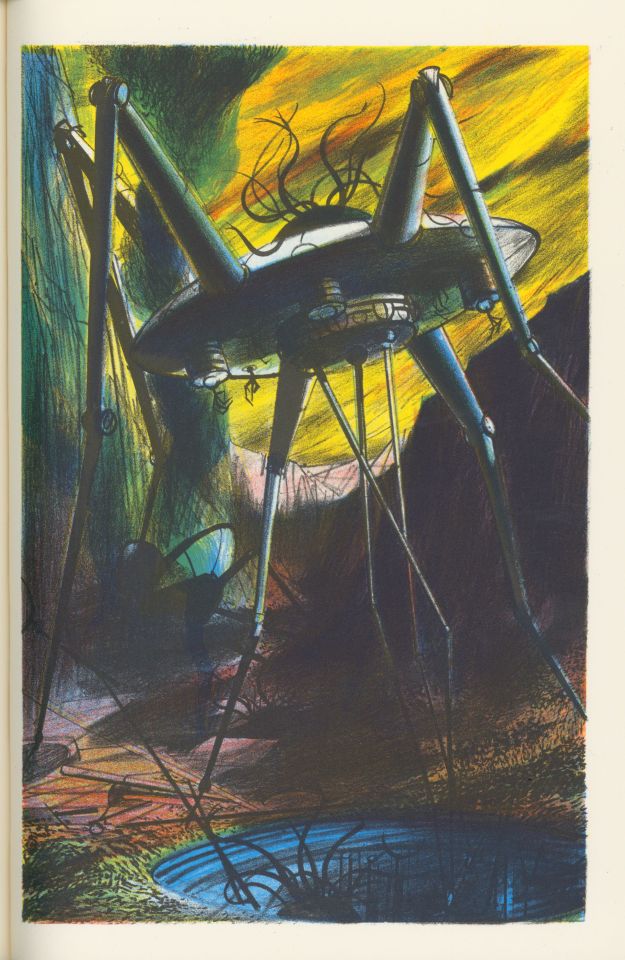
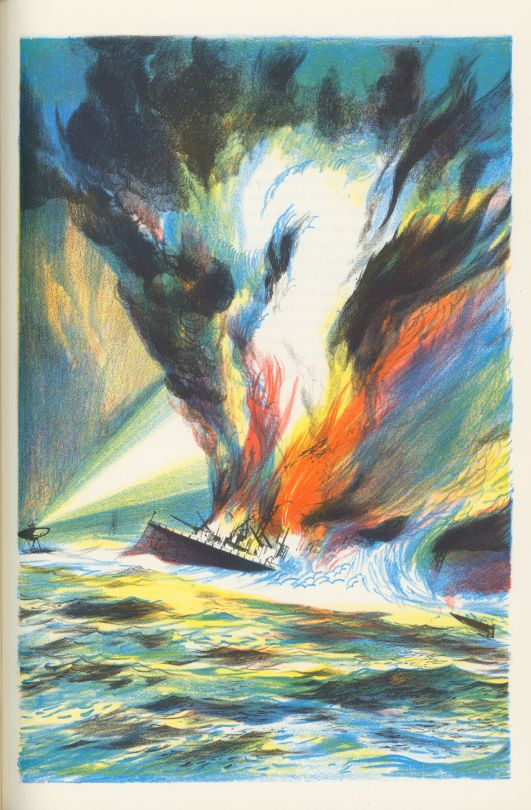
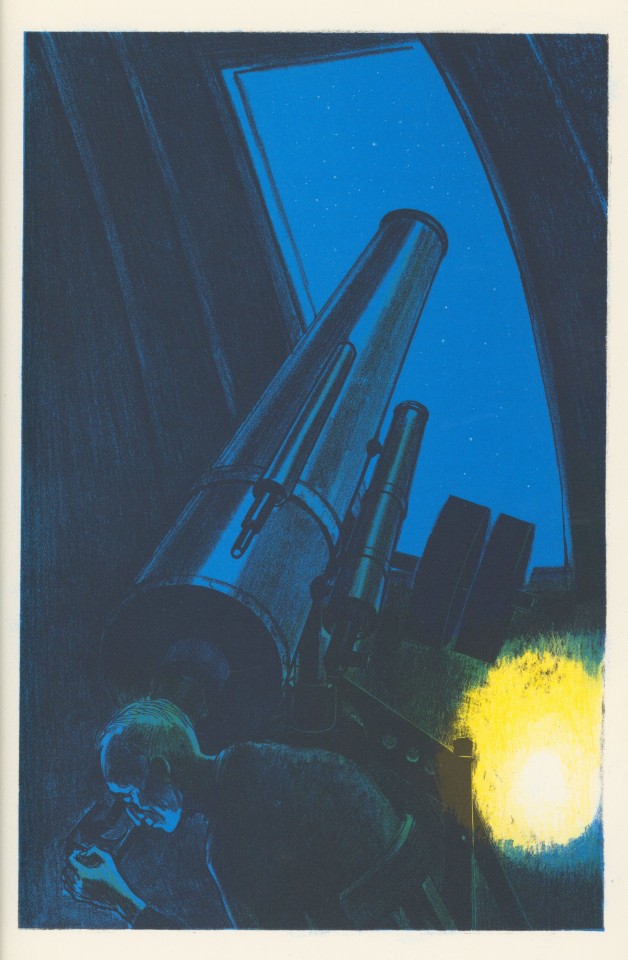
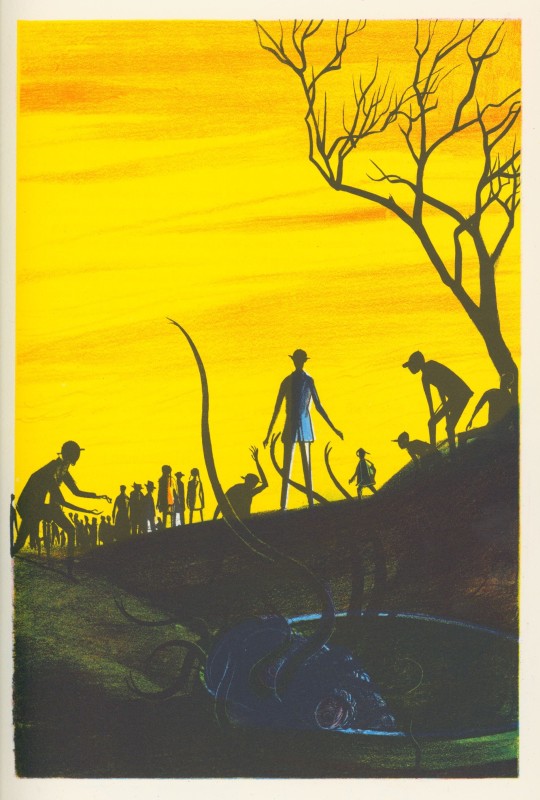

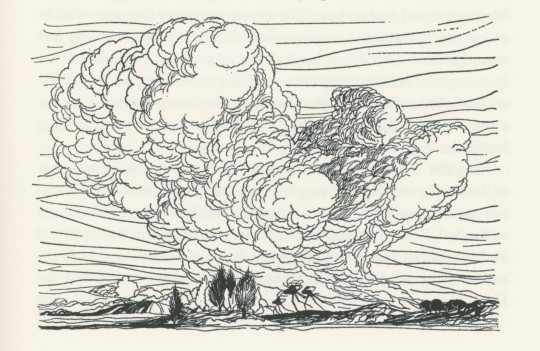
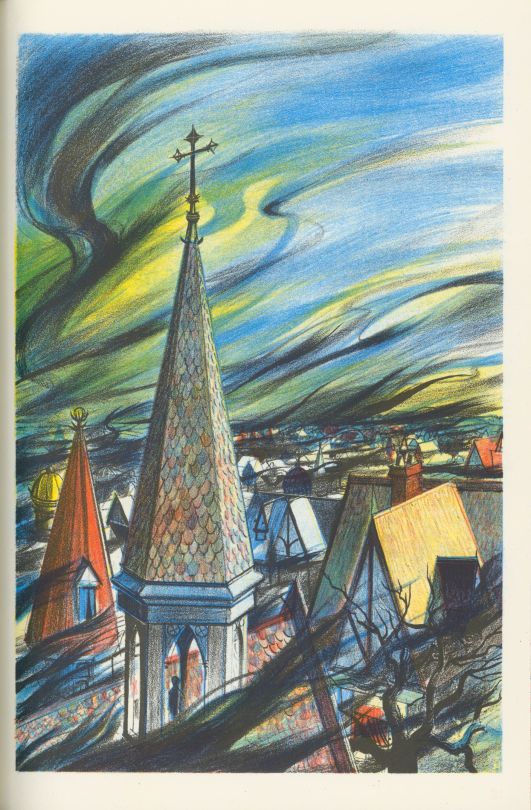
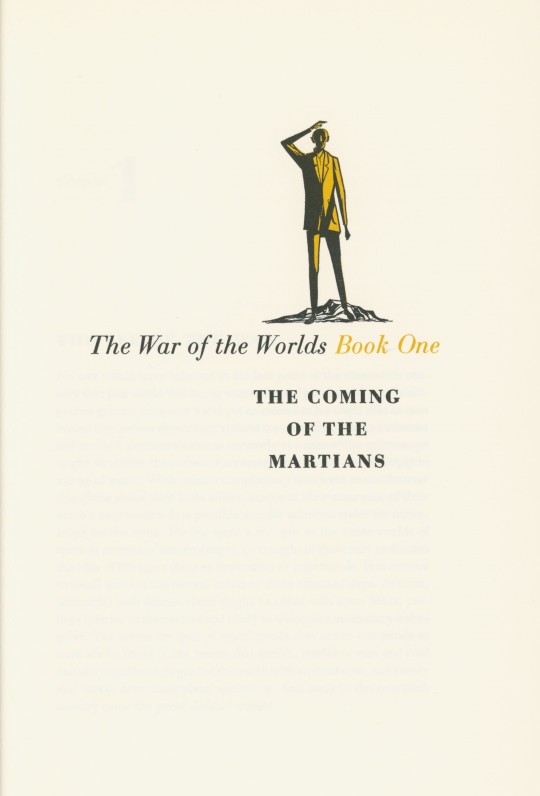
Staff Pick of the Week
First serialized in Pearson’s (UK) and Cosmopolitan (US) in 1897, H.G. Wells’s War of the Worlds wasn’t the very first alien story ever told, but it is probably the most enduring and culturally significant of those early tales. Wells wasn’t just drawing on the nascent genre of science fiction but also the (earthly) invasion literature that was first popularized by George Tomkyns Chesney’s The Battle of Dorking ( Blackwood's Magazine, 1871). Wells later wrote that War of the Worlds was inspired by the genocidal treatment of Aboriginal Tasmanians by British colonizers.
The Limited Edition’s Club edition of H.G. Well’s War of the Worlds was published in 1964. It is illustrated with ten color lithographs, drawn directly on the plates by Joeseph Mugnaini, as well as a number of smaller line drawings by the artist. We posted a few years ago about the Limited Editions Club edition of The Time Machine, also illustrated by Mugnaini. These two books were originally issued together in an ochre-yellow slipcase that matches the end papers; the linen-weave book-cloth bindings are dyed in an opposite color scheme (black with a red spine label for The Time Machine and red with a black spine label for War of the Worlds). The boxed set was designed by Peter Oldenburg and printed on white wove paper from Curtis Paper Company by Abraham Colish at his press in Mt. Vernon, NY. The lithographs were pulled by master printer George C. Miller.
I love how Mugnaini’s colorful illustrations manifest a sense of unease: the yellow and red skies backing the alien invaders, the extreme heat of blue streaked flames, the kaleidoscopic ruins of a building. Mugnaini was best known for his many collaborations with another Science Fiction heavyweight: Ray Bradbury, including cover art for the first paperback and hardback editions of Fahrenheit 451. A previous Staff Pick featured Mugnaini’s illustrations for the Limited Editions Club of Bradbury’s The Martian Chronicles.
You can find more posts on the work of H. G. Wells here.
Check out more from illustrator Joe Mugnaini here.
And here you can find more from Limited Editions Club.
For more Staff Picks here.
-Olivia, Special Collections Graduate Intern
#Staff Pick of the Week#The War of the Worlds#H. G. Wells#Joe Mugnaini#Joseph Mugnaini#Limited Editions Club#Fine Press Books#Fine Press#Invasion Literature#SF#SFF#Science Fiction#Ray Bradbury#lithographs#color lithographs#color lithography#Peter Oldenburg#Curtis Paper Company#Curtis Paper Mill#Abraham Colish#Press of A. Colish#olivia
89 notes
·
View notes
Text
Round One, Match CXXXII


The Fall That Saved Us (Tamara Jerée), Water Sign Books 2023. Cover by Syd Mills.
Something Wicked This Way Comes (Ray Bradbury), Gauntlet Press 1999. Cover by Joe Mugnaini.
12 notes
·
View notes
Text
Excuse me, but this is Moundshoud's House from The Halloween Tree by Ray Bradbury illustrated by Joe Mugnaini.

2K notes
·
View notes
Photo

Left cover is by Joe Mugnaini, 1966; right cover is an unknown artist, 1968
388 notes
·
View notes
Photo








October Country by Ray Bradbury Art by Joe Mugnaini
198 notes
·
View notes
Photo





Happy Halloween! It’s no good for the digestion to just eat one thing over and over again (even if that one thing is Reese’s peanut butter cups), so this week I am looking at some regular books. Everything’s a sourcebook, right?
This is Ray Bradbury’s classic, The Halloween Tree (1972). There are lots of different editions of this book, but I think the first edition cover, which depicts the titular tree, is the best. And that’s largely why I’m here: Joe Mugnaini’s gorgeous illustrations. I picked a couple prime interiors, but my real faves are the illustrations of various masks that top each chapter. Every one is a delight.
The story is…a little dry for my taste. The mysterious Mr. Moundshroud takes a group of children through time to ancient Egypt, the ceremonies of the Druids, to witches sabbaths and Notre Dam and Mexican cemeteries to teach them about the evolution of Halloween and the role fear has taken in the process of civilization. It is sort of a lite version of the Golden Bough at best, at worst a very educational lesson hiding within a spoop story. You’ll learn a lot, probably, but it isn’t exactly thrilling, if you know what I mean.
#RPG#TTRPG#Tabletop RPG#Roleplaying Game#D&D#dungeons & dragons#Ray Bradbury#Halloween Tree#Joe Mugnaini
65 notes
·
View notes
Text





Illustrations by Joe Mugnaini for a 1964 edition of WAR OF THE WORLDS and TIME MACHINE.
1K notes
·
View notes
Photo

247 notes
·
View notes
Photo

British hardcover version of Ray Bradbury's 'Something Wicked This Way Comes' (Rupert Hart-Davis, 1963) Artwork by Joe Mugnaini It’s beautiful!!!
839 notes
·
View notes
Photo

‘R Is For Rocket’ by Ray Bradbury, cover art by Joe Mugnaini, 1962. via CoolSciFiCovers
17 notes
·
View notes
Text
Book Recommendations for the End Times, Part One: The Hopkins Manuscript by R.C. Sherriff

Ready to have your soul simultaneously crushed and uplifted? Sherriff’s your man! The Hopkins Manuscript is a slice-of-(terribly English)-life look at what happens when the moon crashes into the Earth, which isn’t a spoiler because there are so many other dimensions to the characters and world. It was one of the first books I’ve read in a long time which genuinely surprised me by the direction it went. It’s both pessimistic and optimistic. You see the world through the eyes of a chicken-obsessed country squire who fancies himself an impartial scientific observer, but who’s pompous, small-minded, and maddeningly obtuse. His best and only friend is a prize Wyandotte hen called Broodie. However, once he realizes much of humanity is doomed, he slowly begins waking up to all the parts of life that he’s missed. According to the “Foreward,” the manuscript was discovered by an expedition sent by the Royal Society of Abyssinia to probe the wild-dog-infested wastelands of what was once London--in their estimation, it’s “A thin, lonely cry of anguish from the gathering darkness of dying England--infinitely pathetic in the pitiful little conceits and self-esteem of its author.” A great pleasure comes in seeing how this assessment is and isn’t confirmed by the narrative--Sherriff isn’t afraid to make Hopkins unlikeable, or blatantly wrong about people. But he also isn’t afraid to show him changing and learning.
It’s quite fitting for a world staring down the barrel of climate change, where we’ll have to deal with the old rhythms and certainties of nature getting out of whack, and possibly destroying us all. Sherriff is particularly good at describing the grief that comes from being betrayed by things you thought were eternal--be it nature, your country, or the certainty that your annoying relatives will always be there to be looked down upon. It starts off wry and satirical, but beneath the dark humor is a deep love for what humanity is capable of at its best. The little throwaway portraits of how people deal with catastrophe and the knowledge of catastrophe are particularly finely observed.
I read it as a curiosity, but it’s a remarkable book and I highly recommend it if you can find a copy anywhere.
(Illustration by Joe Mugnaini, from the 1963 Macmillan edition)
2 notes
·
View notes
Photo
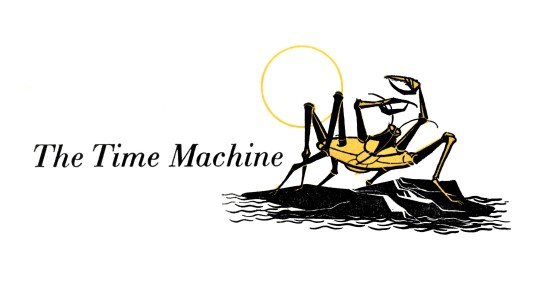
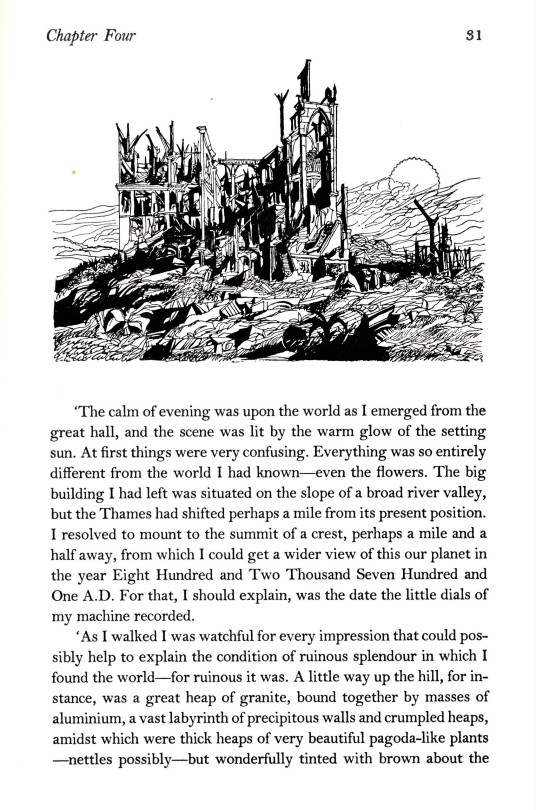
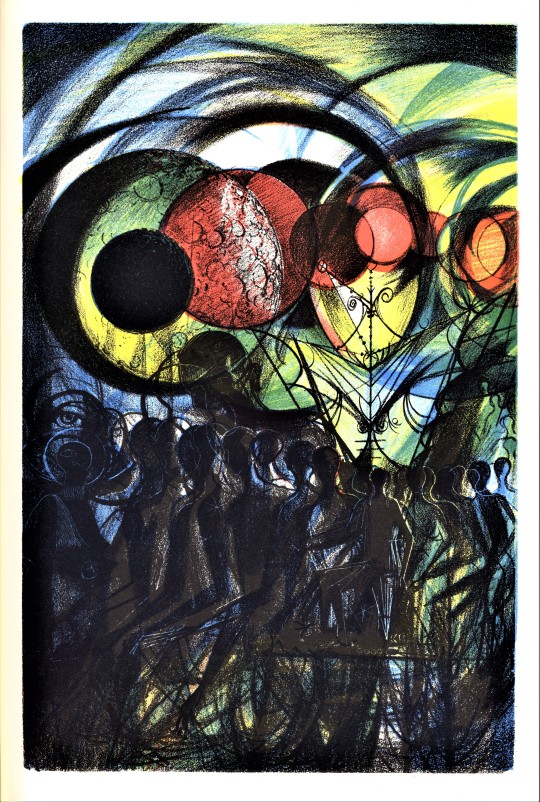
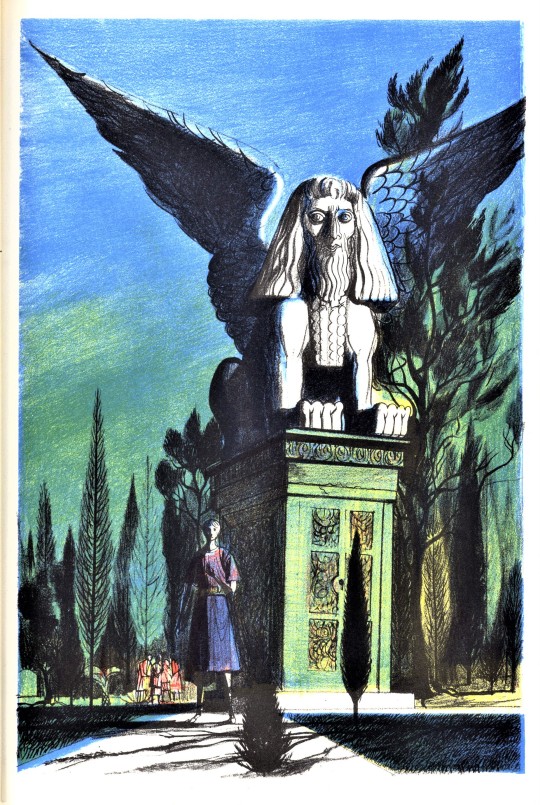

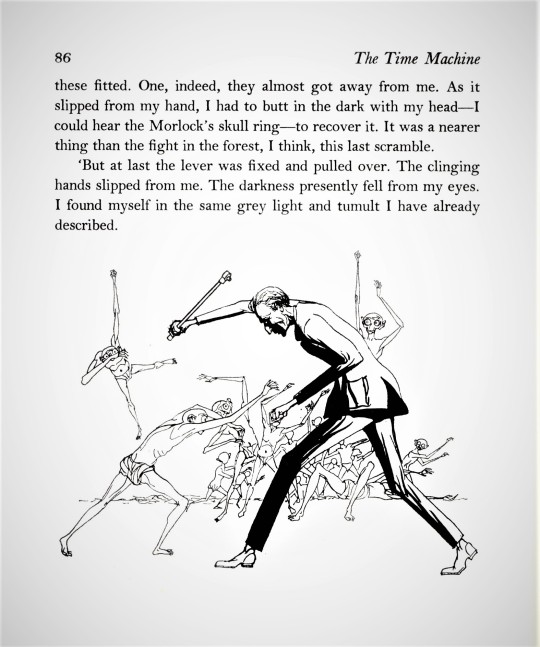
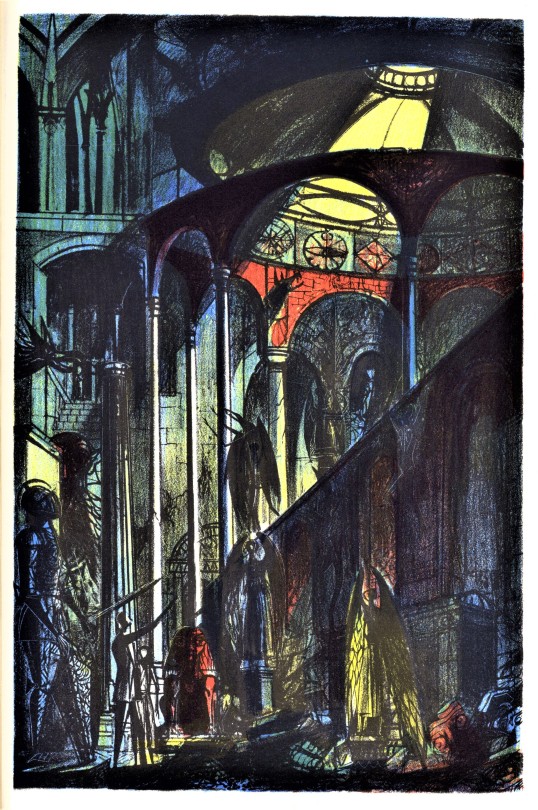
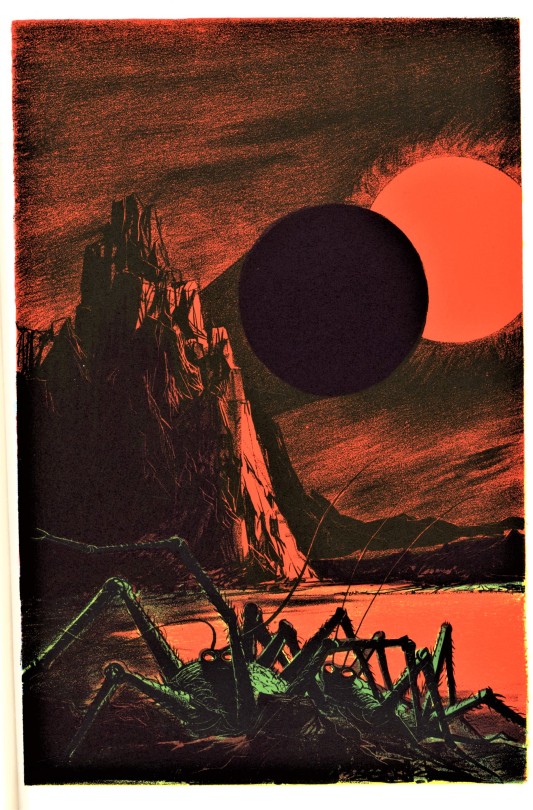

It’s Fine Press Friday!
On this #FinePressFriday before Halloween we present some creepy scenes from a 1964 Limited Editions Club edition of The Time Machine by H. G. Wells, with 16 original color lithographs by American artist and illustrator Joe Mugnaini. The edition, limited to 1500 copies signed by the artist, was designed by Peter Oldenburg in 11-pt. Monotype Bell type on wove paper specially made for this edition by the Curtis Paper Company of Newark, Delaware, and printed at the Press of A. Colish in Mt. Vernon, N.Y.
Mugnaini’s graphic depictions capture the unsettling experiences of the Time Traveler encountering the Eloi in their deteriorating buildings and battling the troglodytic race of the Morlocks in 802,701 CE., as well as the Traveler’s ultimate encounters with a dying Earth millions of years in the future with its final, degenerate inhabitants and a giant, dim, red sun. Mugnaini drew the illustrations directly on the lithographic plates and the prints were pulled by master printer George C. Miller in New York.
View a 1931 Limited Editions Club printing of The Time Machine with equally creepy design and illustrations by the famed graphic designer W. A. Dwiggins.
View more Fine Press Friday posts.
#Fine Press Friday#Fine Pres Fridays#Halloween#holidays#pagefrights#H. G. Wells#The Time Machine#Limited Editions Club#Joe Mugnaini#lithographs#color lithographs#George C. Miller#Peter Oldenburg#Press of A. Colish#Curtis Paper Company#Monotype Bell#fine press books
109 notes
·
View notes
Photo

Left cover is by Joe Mugnaini, 1966; right cover is an unknown... https://ift.tt/SvqUrXc
1 note
·
View note
Text

The British hardcover version of Ray Bradbury's 'Something Wicked This Way Comes' (Rupert Hart-Davis, 1963), with Joe Mugnaini's 'Carnival' train rumbling both across the cover and throughout the novel's development.
4 notes
·
View notes
Photo

r is for rocket (1962, jacket illustration by joe mugnaini)
71 notes
·
View notes
Photo

The October Country by Ray Bradbury, 1955 Illustrated by Joe Mugnaini
#joe mugnaini#the october country#ray bradbury#1955#1950s#vintage#art#illustration#scifi#sf#scifi art#science fiction#sf art#science fiction art#painting
282 notes
·
View notes